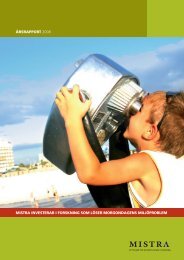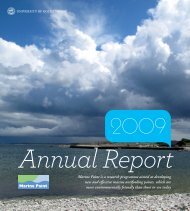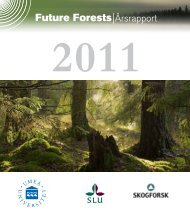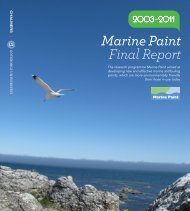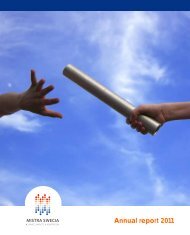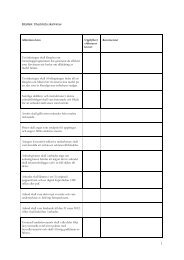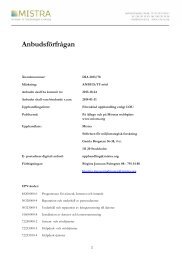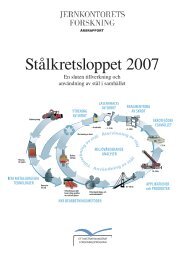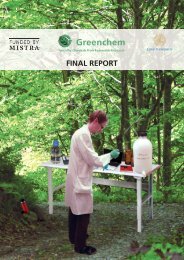Institute Excellence Centre (IEC) EcoBuild - Mistra
Institute Excellence Centre (IEC) EcoBuild - Mistra
Institute Excellence Centre (IEC) EcoBuild - Mistra
Create successful ePaper yourself
Turn your PDF publications into a flip-book with our unique Google optimized e-Paper software.
2<strong>Mistra</strong> Future Fashion Annual Report 2011
Directors’ ViewWe are proud to introduce the first annual report of <strong>Mistra</strong> Future Fashion – a truly cross disciplinaryresearch program that started in June 2011. In this program researchers within environmentalscience, business and CSR science, behavioral science, political science, sustainabledesign science, psychology and technical sciences are working together to initiate a systemicchange of the fashion industry towards sustainability.The program started in June 2011, which means that the first annual report only covers approximatelyhalf a calendar year. This first period of the program has mainly been devoted toestablishing the program organization, including building up a managerial and administrativestructure, and developing a communication & outreach strategy. Furthermore, a lot of effortwas put into drafting and re-drafting a Consortium Agreement which is now finally approvedby all parties. However, during this short period most PhD students have been recruited andhave already started up their projects. Many collaboration tasks linking the different projectstogether have also been started or planned.Partly due to the cross- and trans-disciplinary character of the program, we feel that there is alot of positive energy being created through the interfaces between the different disciplinesand that this energy will help us to achieve our objectives.Mats WestinProgram DirectorÅsa ÖstlundDeputy Program Director3<strong>Mistra</strong> Future Fashion Annual Report 2011
1. Program FundingThe over-all turnover for <strong>Mistra</strong> Future Fashion is expected to reach at least 110 million SEKfor eight years (2011–2019). In this budget, the main funding organization is <strong>Mistra</strong>, theFoundation for Strategic Environmental Research, who supports the program with 40 millionSEK over the first 4 years and after that another 40 million SEK if the Program is successful.Södra Skogsägarna’s Research Foundation is contributing with 1.2 million SEK over the first4 years and the agreed counter-financing from the industrial and organisation Parties (at presenta cluster of 10 parties) is at least ca 15 million SEK for the first 4-year period.An evaluation of Phase 1 (2011–2015) will take place during spring 2015 which, combinedwith an approval from a cluster of continuing and new Program Parties, will form the basisfor funding of Phase 2 (2015–2019).Read more about the research program and financers at:1) www.mistrafuturefashion.com2) www.mistra.org3) http://www.sodra.com/sv/Om-Sodra/Forskning/Forskningsstiftelsen/The industrial and organization parties (contributing in-kind to the Program activities):Industry parties- Fabric Retail Global AB- F.O.V. Fabrics AB- H&M Hennes & Mauritz AB- I:Collect AG- Kiram AB- Södra SkogsägarnaOrganisation and agency parties- Environmental Protection Agency- Myrorna (Salvation Army 2 nd hand)- Protekostiftelsen- Swedish Chemicals Agency4<strong>Mistra</strong> Future Fashion Annual Report 2011
2. CHAIRMAN OF THE BOARD, PERNILLA WALKENSTRÖMKjhdkjhkljsdkjlkjlkjkjhkkjhuhlkäps6<strong>Mistra</strong> Future Fashion Annual Report 2011
3. WHAT IS THE PURPOSE OF THE PROGRAM?3.1 Vision, expected results and effects of the programThe ultimate objective is that the program research will initiate a systemic change of the SwedishFashion industry that leads to sustainable development of the industry and wider society,while at the same time strengthening the competitiveness of this industry.Specific expected outcomes of this trans-disciplinary research program include a) recommendations/strategiesfor different stakeholders how to bring about systemic changes in the fashionindustry; b) educational and feedback material for designers regarding design tools; c)shortened time to market introduction of novel textile fibers that are more sustainable thancurrent alternatives; d) some major environmental problems within textile processing industryand use phase of textiles will be solved; e) textile recycling leading to high-value productsthrough dissolution and spinning of new fibers of virgin quality, f) toolbox of communicationstrategies according to identified target groups; g) suggested framework of policy instrumentsleading to more sustainable fashion.Combined with each other, these outcomes have a capacity of making Swedish fashion industrymore competitive by turning sustainability into a business advantage.3.2 Overall Program Structure and StrategyThe board has the overall responsibility for the program and answers to <strong>Mistra</strong>.The Management Team lead by the program director, reports to the Board and coordinates theresearch.The research is organized in eight research projects:P1. Changing markets & business models: Towards sustainable innovation in the fashion industryP2. Clarifying sustainable fashionP3. Interconnected design thinking and processes for sustainable textiles and fashionP4. Moving towards eco-efficient textile materials and processesP5. Reuse, recycling and End of life issuesP6. Fashion for the public sectorP7. Sustainable consumption and consumer behaviorP8. Policy instrumentsA communication committee lead by the Head of communication, is responsible for seeing tothat both internal and external communication is functioning in an efficient way.7<strong>Mistra</strong> Future Fashion Annual Report 2011
4. INTERVIEW WITH JOHAN WARD, H&Mxxxxxxxxxxxxyyyyyyyyyyyyyyyyyyy8<strong>Mistra</strong> Future Fashion Annual Report 2011
5. ESTABLISHMENT OF THE MISTRA FUTURE FASHIONDuring 2011, prior to the start of the program, the Board and the Program Management teamwere formed. At the kick-off meeting, the project leaders presented their project plans andopened up for comments and suggested changes for these from the audience. Half a monthlater the researchers met and discussed research integration between the projects. After thesetwo meeting the project plans were slightly refined. During the first months of the program,routines for how the board and management team should function was set up and the communication& outreach strategy for 2012 and beyond was worked out.5.1 Organization of the programThe basic organization of the programme is shown in the illustration below.Program BoardMISTRAManagement TeamProgram DirectorMats Westin (SP)Deputy Program DirectorÅsa Östlund (SP)Communicator:Coordinator of Social Science projects:Mike Shragger (Sustainable Fashion Academy) Susanne Sweet (SSE)Administrative support fromSPCarina Lydén (Controller), NN (secreterary)Communication CommitteeMike Schragger(SFA), Cecilia Nielsen (SP),Communicator (TED), Communicator (Konstfack), etc.P1Project leaderP2Project leaderP3Project leaderP4Project lederP5Project leaderP6Project leaderP7Project leaderP8Project leaderEsbenPedersenGregoryPetersRebeccaEarleyDesiréRexHaraldBrelidMikaelLindströmWenckeGwozdzTomNilsson(CBS)(Chalmers)(TED,UAL)(Swerea)(Chalmers)(Innventia)(CBS)(Malmö Univ.)Project teamCBSSSEBSRChalmersProject teamChalmersSP, SwereaInnventiaCBS, MaHProject teamTEDKonstfackInnventiaProject teamSwereaInnventiaChalmersProject teamChalmersSwereaSPProject teamInnventiaSwereaKonstfackProject teamCBSSSEChalmersProject teamMalmö Univ.Naturvårdsv.ChalmersImplementation in industry, organisations and the public sectorOrganization scheme of <strong>Mistra</strong> Future FashionProgram BoardAt the Kick-off meeting of the program, the Board members presented themselves.9<strong>Mistra</strong> Future Fashion Annual Report 2011
Board members from left: Johan Ward (H&M), Mona Blomdin Persson (Management of SwedishChemicals Agency), Jonas Eder-Hansen (R&D Manager, Danish Fashion <strong>Institute</strong>), Karin Emilsson(CTO, Södra), Ulf Carlson (Head of Dept of Chemical and Biotechnical Engineering, Chalmers Univ.of Tech.), Nick Morley (Oakdene Hollins), Per-Erik Petersson, (CTO, SP), Pernilla Walkenström (AreaManager Swerea IVF/Assoc. Prof. Swedish School of Textiles).Two Board meetings were held during 2011, one after the kick-off at SP in Borås and the secondin September at Chalmers, Gothenburg. Rules of procedure for the Board has been preparedas defined in the Consortium Agreement.Program Management TeamThe Program Management consists of the Program Director, Dr. Mats Westin (SP), and theDeputy Program Director, Dr. Åsa Östlund (SP/Chalmers), Head of Communication, MikeSchragger (Sustainable Fashion Academy) and Coordinator of Social Science projects, Dr.Susanne Sweet (Stockholm School of Economics). Mats’ role is to handle the over-all guidanceof the Program development, communication with the Board and to be updated on thegeneral activities within the projects and communication committee. Åsa’s role is to coordinatemeetings (of the management team, project leaders, researchers and of the wholeprogram), and to address special attention to the technical and environmental science projects(P2, P4, P5 and P6), report on their progress and problems to the rest of the Management teamand act as support for the researchers of these projects. Mike’s role is to plan and lead thecommunication & outreach activities and report on these to the Man. Team. Susanne’s role isto address special attention to the design and social science projects (P1, P3, P7 and P8), reporton their progress and problems to the rest of the Management team, act as support for theresearchers of these projects and facilitate cooperation between all projects.Man. Team members from left: Mats Westin, Åsa Östlund, Michael Schragger and Susanne Sweet.CommunicationHead of communication is Mike Schragger (see above)The rest of the communication team are shown below:10<strong>Mistra</strong> Future Fashion Annual Report 2011
Dr. Finn Englund, SP Trä, function as the program’s Newsletter Editor andTeam-site administrator.Karolina Wikander, SP Communication, constructed the web site and ishelping out with updating it.Cecilia Nielsen, Head of SP Communication, invited to the first press conferenceand has after that been a discussion partner for Mike concerningcommunication and outreach strategies.Staffan Ljung, SP’s Media Relations Officer, has helped Mike with the formulationof media guidelines.Persons involved in <strong>Mistra</strong> Future Fashion during 2011 (some statistics)Approximately 50 persons with specific competences have been connected to the Programduring 2011. Of these persons were– 22 PhDs– 13 Professors– 1 Technology Licentiates. (from institute)– 2 postdocs– 6 PhD students (2 employed by institutes)– 20 employed at institutes– 25 employed at Universities– 18 employed at the industry– 4 researchers with split positions between universities and institutes11<strong>Mistra</strong> Future Fashion Annual Report 2011
In total this corresponds to– Xx.x person years that can be related to the program.– x.x person years directly financed by the program– x.x person years accounted at the industry– x.x person years by PhD students– x.x person years by PhD student directly financed by the programProject LeadersThe following eight researchers were acting as project leaders during 2011:P1Esben RG PedersenCopenhagen BusinessSchoolP2Gregory PetersChemical EnvironmentalScience, ChalmersP3Rebecca EarleyUniversity of the ArtsLondonP4Desiré RexTextiles and Plastics,Swerea IVFP5Harald BrelidForest Products andChemical Engineering,ChalmersP6Mikael LindströmInnventiaP7Wencke GwozdzCopenhagen BusinessSchoolP8Tom NilssonPolitical Science,Malmö University12<strong>Mistra</strong> Future Fashion Annual Report 2011
6. SHORT OUTLINE OF THE PROGRAM RESEARCH PLAN13<strong>Mistra</strong> Future Fashion Annual Report 2011
7. COMMUNICATION & OUTREACH7.1 Development of the strategy7.2 Activities and realization of the Communication StrategyThe following communication and dissemination activities related to <strong>Mistra</strong> Future Fashionand its Communication Strategy have been realized during the first year:Seminars and workshops arranged by MiFuFa[1]. XXXX[2]. hkdlkdslCourses arranged in cooperation with MiFuFahkjlsdklMiFuFa NewslettersNo newsletters were published during 2011.Oral conference contributions, seminar presentations and lectures related to the program(chronological order)[1]. hsdjalkjd14<strong>Mistra</strong> Future Fashion Annual Report 2011
[2]. ksdköasdlöExternal webpageSee www.mistrafuturefashion.comInternal webpageAn internal MiFuFa webpage, the “team site”, is available for the participants in the programthrough a ”login” function at the external webpage. The main purpose of this site is to facilitatemeans for an efficient general communication within the program, communication andelectronic document handling within the program’s projects, Program Management andBoard. The security level of the team site is designed to be able to deal with confidential informationand IPR within the program.The level of acceptance for this type of communication is growing among the program participants,but needs to be increased in the future.Program Meetings and Seminars, 2011The <strong>Mistra</strong> Future Fashion kick-off meeting attracted over 40 participants amd 12 speakers(not including board members presenting themselves). The meeting was held in English andthe program is shown belowTable X. Program for Kick-off Meeting of <strong>Mistra</strong> Future Fashion, May 25, 2011.09:30-10:00 Registration, coffee and mingle10:00-10:15 Opening of the meeting & introductionby Mats Westin, Programme Director, and Åsa Östlund, Deputy Programme Director10:15-10:30 Introduction by Britt-Inger Andersson, MISTRA10:30-11:00 Presentation of the Program Board11:00-11:30 Presentation of preliminary communication strategy11:30-12:00 Presentation of Program projects and Project leaders12:00-13:00 Lunch (in the room nextdoor)13:00-15:00 Presentation of Program projects and Project leaders, continued15:00-15:15 Coffee break15:15-16:15 Presentation of Program projects and Project leaders, continued16:15-16:40 General discussion of the research program16:40-17:00 Planning of future meetings and closing of the meetingThe <strong>Mistra</strong> Future Fashion half-year meeting attracted over 40 participants, 15 from industry,19 speakers. The meeting was held in English and the program is shown below.15<strong>Mistra</strong> Future Fashion Annual Report 2011
Table Y. Program for the Half-year Meeting of <strong>Mistra</strong> Future Fashion, Nov 24, 2011.09:30-10:00 Registration, coffee and mingle (outside Room 720)10:00-10:45 Welcome & updates about the program (Mats/Åsa/Susanne/Mike)10:45-11:50 Status report, research projects (Project leaders)11:50-13:00 Lunch (in the Ohlin room)Afternoon sessions: Some stakeholders' view:- Their current work within the program research area- How they see possible interaction with the program research- Their expectations on the outcome of the program research13:00-13:50 Mona Blomdin Persson, Swedish Chemicals Agency (KemI)13:50-14:45 Christoph von Hahn, I:CO and SOEX14:45-15:15 Coffee break15:15-16:00 Presentation of Program projects and Project leaders, continued16:00-16:45 General discussion of the research program16:45-17:00 Closing the seminar17:15-19:00 Dinner in Terrassrummet, SSE, Holländargatan 3216<strong>Mistra</strong> Future Fashion Annual Report 2011
Pictures from the half-year program Meeting held at Stockholm School of EconomicsPublicationsAs shown in the list below, xx research reports have been published, submitted or drafted during2011. The reports can be divided into: x manuscripts submitted for publications in peerreviewedjournals, x manuscripts drafted for submission to peer-reviewed journals, xx oralpresentations at international conferences published as papers in their conference proceedings,and x reports.[1]. Woolley, Roos S, Peters G, Rahimifard, Jönsson (2011). Special ecodesign considerationfor the textile industry. Submitted to Journal of the Textile <strong>Institute</strong>.[2]. Bly, S., Gwozdz, W. & Reisch, L. (2011). Exit from High Street: a study of sustainablefashion pioneers’ strategies for sustainable fashion consumption (Accepted conferencepaper for the Nordic Conference of Consumer Research, May 30 – June 1 2012,Gothenburg (SE), unpublished)[3].[4]. Pedersen E RG (2012). Corporate Social Responsibility (CSR) and Sustainability in theNordic Fashion Industry - A Cross-Country Comparison. A Report.[5]. Pedersen E RG, Timmerman HL, nn (2012). Tentative title:“Innovative business modelsfor the fashion industry”. To be completed and submitted to a scientific journal.[6]. Pedersen E RG, NN, NN (2012). Tentative title: Mapping Sustainable Fashion: TheStakeholder Network surrounding the Fashion Industry’s Sustainability Activities”. ”.To be completed and submitted to a scientific journal.[7]. Pedersen E RG, Gwozdz W (2012). Tentative title: “From Resistance to Opportunity-Seeking: Strategic Responses to Institutional Pressures for Corporate Social Responsibilityin the Nordic Fashion Industry”. To be completed and submitted to a scientificjournal.[8].[9]. Sandin G, Peters G, Svanström M (2012). Moving down the cause-effect chain of waterand land use impacts: an LCA case study of textile fibres. To be submitted to a scientificjournal during 2012.[10]. Zamani B, Svanström M, Peters G (2012). Explorative life cycle assessment of textilerecycling techniques. To be submitted to a scientific journal during 2012.[11].4.2 Popular science publications[1]. ljlskjPatent applications[1]. lökfölksölk17<strong>Mistra</strong> Future Fashion Annual Report 2011
8. ACTIVITIES AND RESULTS FROM THE RESEARCH PROJECTSProject 1. Changing markets & business models: Towards sustainable innovation in thefashion industryIn 2011, interviews were made with a number of informants with knowledge of the Swedishfashion industry. The interviews were semi-structured and based on a number of predefinedinterview questions. The interviews are part of a fact finding exercise on sustainability/CSR inthe fashion industry. Interviews will continue in 2012. The insights from the interviews willbe integrated in a report on Sustainability/CSR in the fashion industry (see below).In 2011, the work on a report on sustainability/CSR in the fashion industry was begun. Thetentative title of the report is: Corporate Social Responsibility (CSR) and Sustainability in theNordic Fashion Industry - A Cross-Country Comparison. The report is based on a review ofthe existing literature within the field of sustainable fashion, information on the fashion industryin the Nordic countries, and insights from the expert interviews (see above). The reportwill be completed in 2012.In 2011, a review of relevant literature within the field of sustainable business models andinnovation was conducted (to be continued in 2012). The results from the review will result ina working paper and serve as the basis for a survey to be launched in 2012. The tentative titleof the working paper is “Innovative business models for the fashion industry”. At present, thepaper is co-authored by Esben Rahbek Gjerdrum Pedersen and Heather Lynn Timmerman. In2012, the paper will probably get input from more co-authors, not least the new PhD students(see below).In 2011, a review of relevant literature within the field of stakeholder network analysis wasconducted (to be continued in 2012). The results from the review will result in a working paperand serve as the basis for a survey to be launched in 2012. The tentative title of the workingpaper is “Mapping Sustainable Fashion: The Stakeholder Network surrounding the FashionIndustry’s Sustainability Activities”. The working paper will be authored by EsbenRahbek Gjerdrum Pedersen in collaboration with one or more co-authors from project 1.In 2011, planned and implemented a survey among Nordic fashion companies. The surveyincluded a number of questions relevant for the MISTRA Programme and project 1. The mainobjective of the survey was to explore how the market and nonmarket environments influencethe variety and content of CSR activities in the Nordic fashion industry. Moreover, the paperdeveloped and tested a new model of strategic responses to institutional pressures that encompassresistance, conformance, and opportunity-seeking behaviour. The survey resulted invalid responses from 400 fashion companies in Denmark, Norway, Sweden, Finland, and Iceland.The main results from the survey has been used in a manuscript entitled “From Resistance toOpportunity-Seeking: Strategic Responses to Institutional Pressures for Corporate SocialResponsibility in the Nordic Fashion Industry” (Completed in 2012). The paper is coauthoredby Esben Rahbek Gjerdrum Pedersen and Wencke Gwozdz. In short, it is concludedthat CSR in the fashion industry is very much about compliance rather than innovation. However,increasing CSR pressures tend to stimulate resistance as well as opportunity-seeking atthe expense of compliance behaviour. In addition, the results indicate that inconsistent pressureswithin, stakeholder impact the responses of fashion companies to CSR pressures. Companiesexperiencing consistent pressures are more likely to conform with requirements and ingeneral have higher social and environmental performance. In other words, internal stakeholderhypocrisy may drive down CSR performance. Last, companies with organic character-18<strong>Mistra</strong> Future Fashion Annual Report 2011
istics are more likely to be active on the CSR agenda compared to more mechanistic organisations.However, organizational structure seems to be unrelated to CSR performance.In 2011, a call for a PhD in sustainable fashion to join Project 1 was launched. The name ofthe successful candidate is Kirsti Andersen. Kirsti Andersen will begin her PhD in 2012(Week 15). Kirsti holds a Master degree in European Cultural Studies from Aarhus Universityand have worked as a Project Manager and Researcher at the Copenhagen <strong>Institute</strong> of InteractionDesign for the past 5 years. The proposed PhD Project investigates the relationship betweenorganizational culture and a fashion company’s ability to develop new sustainable practicesand business models. It does this through the application of the French sociologist andphilosopher Pierre Bourdieu’s theoretical triad consisting of habitus, capital, and field, coupledwith an ethnographic approach to data collection.In 2011, Copenhagen Business School launched a general call for PhDs. Candidates for thePhD in Sustainable Fashion were also encouraged to apply for this PhDs. The strategy turnedout to be successful and we are therefore able to welcome an additional PhD to join Project 1.The name of the successful PhD is Frederik Larsen. Frederik Larsen will begin his PhD in2012 (Week 15). His project investigates value creation in second hand clothing markets.From a background in visual culture studies, Frederik has previously done research on innovation,fairs and sustainability in the fashion industries and explored the relationship betweenmateriality, meaning and clothing.In 2011, a meeting was arranged with Meeting Stavanger University. Stavanger Universityhas been involved in a large study of corporate social responsibility (CSR) in the fashion industry.The results from their work can be found here, Some of the insights from the studymay also be of relevance for Project 1 (as well as other projects within the MISTRA FutureFashion Programme).In 2011, a meeting was arranged with Peder Michal Pruzan-Jørgensen from BSR(www.bsr.org) to discuss their involvement in the project. It is for instance expected that BSRmay play a pivotal role in communicating the findings from the MISTRA Future FashionProgramme.In 2011, work was done on detailed project plan, consortium agreement, research design etc.This work also included meetings in Stockholm, London, and Borås.In 2011, project participants established initial contacts with potential case companies. Firstcase studies will take place in 2012.Project 2.Clarifying sustainable fashionFuture Fashion began operations in the second half of calendar 2011. Senior research time inProject 2 in this period was focused on building relationships within the consortium and hiringresearchers.As initially presented at the kickoff meeting on 25 May, Greg Peters began developing aflowchart identifying the potential informational exchanges between Project 2 and the otherprojects over the four year course of the overall project. Despite him going on paternity leavein mid September, initial meetings were held regarding technical exchanges with Project 1(Esben Pedersen; 24 November), Project 3 (Rebecca Earley; 7 November), Project 4 (Anna-Karin Jönbrink, Sandra Roos; 1 June & 22 November), Project 5 (Harald Brelid; 8 November),Project 6 (Mikael Lindström, 24 November) and Project 7 (Wencke Gwozdz & SarahNetter; 1 November). Relatedly, meetings between Sandra Roos, Anna-Karin Jönbrink andMikael Lindström occurred on 2 November and Sandra and Anna-Karin talked with the consortiumleaders on 9 December. All these meetings resulted in a better understanding of what19<strong>Mistra</strong> Future Fashion Annual Report 2011
each project leader might want from Project 2, and have lead to the outcomes and plans mentionedin the rest of this document, among others. Additionally, with Mike Schragger materialsand information were exchanged and a meeting was held (24 November) as part of FutureFashion’s internal communications.Significant time and effort was expended in Project 2 in order to bring in the best possiblepostgraduate researchers for the work. Advertisements for the university position were madeonline and in the technical press, over two dozen applicants were evaluated and five wereinterviewed. This resulted in Bahareh Zamani joining the project in mid September. She hasprevious practical experience in the application of sustainability assessment to textile systemsanalysis through a masters thesis at IVL. The other key addition to the team was SandraRoos, and industrial PhD candidate employed by Swerea. Applications for additional fundingto support her candidacy (and based on their unsuccessful outcome) challenging negotiationsbetween the parties, took until December to finalise. Sandra is a very experienced in mattersof textile chemical management and her enrolment at Chalmers is a very practical way of increasingthe cross-pollination of ideas between partners to the consortium agreement, particularlyChalmers and Swerea.Gustav Sandin was already enrolled as an industrial research student but Future Fashion hasextended his funding to cover a full PhD. Most of his work on the project will occur in 2013and 2014, but with Greg Peters and Magdalena Svanström he worked in 2011 on drafting anarticle regarding sustainability metrics for forest resource extraction, which contributes to theaims of Project 2. The paper is undergoing further improvement prior to submission to a scientificjournal.Bahareh, Magdalena and Greg spent time drafting an article for publication in a scientificjournal exploring the topic of technology preferences in textile recycling. It is intended thatthis should provide support for future collaborations between Project 2 and Project 5. Baharehalso completed two of the compulsory courses for new doctoral students: Information literacyand Challenges and opportunities of technology in sustainable development.Additional dialogue with Project 7 staff regarding the addition of social sustainability questionsto a survey to be subcontracted by CBS in early 2012 was directed towards finding anappropriate set of questions and type of language to engage with the interviewees. This workwas informed by a literature review of social impact assessment literature in Project 2 inwhich Gustav and Bahareh were active.Project 3.fashionInterconnected design thinking and processes for sustainable textiles andA. PhD Project – Clara has rewritten some aspects of the RF3 – the formal project proposal –for the college research committee. She extended the discussion around auto ethnography andfurther bibliographic analysis of the ‘social’ aspect of her project, making more references tokey case studies.In the first three months of the project (October – December 2011) Clara:1. Began research for a consultancy project (working with social branding and CSR experts)develo ing a model for how a garment factory could become a hub for social innovation, for aUS apparel company.20<strong>Mistra</strong> Future Fashion Annual Report 2011
2. Attended several conferences and events including Social Business Conference, Londonand RITE Group Green Textiles Conference, London and Stockholm Green Hackathon,Stockholm.3. Began to map case studies for new creative workshop methodologies.B. Development of TED’s TEN cards & workshop content and techniques:1. Large Companies – H&M Pilot continues to be discussed and is still at draft proposalstage. Work has been completed around the appropriate allocation of research hours and costing& timings for delivery. An agreement between UAL, Mike and H&M has been drafted byUAL, and needs discussion. (Becky and Mike scheduled to Skype Friday 16 th March!)2. SME/Individual Entrepreneurs – Pilot ‘Research Focus Group’ programme at Chelseadue to complete on April 18 th with a one---‐day workshop. Outcomes to be presented on thewebsite, and included in the year2 report.3. Workshop facilitation experts – TED researchers continue to work with workshop content.Fashion Services with Snook’s Lauren Currie took place here in early March:http://blog.tedresearch.net/2012/03/07/service---‐design---‐workshop/http://www.wearesnook.com/snook/CCW is also supporting Becky to work on facilitation with Rachel Gilmore –http://www.rachelgilmore.com/4. TED’s TEN cards industry feedback – the cards have been sent to a number of academicsand industry professionals for review and feedback.C. Product developmentKay, Becky and Clara have been completing a curation and production development commissionfor VF Corp in USA, and a number of new sustainable fashion prototypes have been developedin TED. VF have the option to buy these and obtain the IP from us, but if they do nottake this option by mid April then we will have some new sustainable fashion ideas to bringinto the MFF project. Watch this space…D. Websitewww.textiletoolbox.com – The site is being designed by http://www.polimekanos.com/ andwill be fully functionalö by the beginning of April and will form the basis of P3’s presentationin Copenhagen in May. The site will be a useful tool at this stage to work towards the report/journaledition, planned for the end of MFF year 2, and has been designed to invite fashionuser feedback and interaction.E. Management – P3 will now report to Susanne Sweet, with the aim of encouraging andsupporting a range of interactions with other projects, including potential co-authoring of academicpapers.21<strong>Mistra</strong> Future Fashion Annual Report 2011
Project 4. Moving towards eco-efficient textile materials and processesTrials and resultsSwerea IVF has ordered new yarn twisting equipment that arrived in the beginning of 2012.Yarns of different qualities has been ordered to start collect a library of yarns to work with, inthe new machine.In <strong>Mistra</strong> Future Fashion the goal is to find new bio-based material that have as less impact onthe environmental as possible. CelluNova is a fiber that is in the developing phase in anotherproject at Swerea IVF among others. This new fiber is made from dissolving pulp and withmore environmentally solvent, comparing for example viscose. This fiber is still in the developingphase and therefore not ready to use yet. But some fibers are available and sampleshave been made as nonwoven material. To compare the CelluNova fibers with already existingfibers and to see how it reacts together with other materials further nonwoven sampleswere done. See table X below.Table X. Nonwoven samples of CellNova blendings and Lyocell.Material Thickness(dtex)Composition100 % CelluNovdled2.0 dtex Carded and nee-50 % CelluNova2.0 dtex Carded and nee-2.2 dtex dled50 % Modacrylic50 % CelluNova2.0 dtex Carded and nee-7.0 dtex dled50 % Polyester100 % Lyocell 6.7 dtex Carded and needledCommentsVery soft and comfortable feeling.Soft and comfortable, feels little morestabile.Little stiffer feeling, but still fluffy.Stif and rough, but probably becausethick fibers (6.7 dtex).Before carding the CelluNova fibers went through a mechanical texturing process. This leadsto crimped fibers that behave better in the carding step. None crimped fibers sticking in eachother and creates not wishful lumps.CelluNova is working well in blending with other materials. The strength of the fiber are untilnow not as strong as viscose especially not in wet condition. Therefore it is suitable to blendup the material with some other stronger fibers for example cotton or polyester. This operationcan be done in the yarn twisting step and will be performed in a small scale during 2012.In the nonwoven sample with 100% Lyocell the fibers are really thick, high dtex. This leadsto a stiff and rough feeling that not is comparable to the smooth CelluNova fibers. So thethickness of the fibers has really high impact on the feeling of the material. A good exampleon that is microfibers that feels really smooth because of its thin structure, usually less than1.0 dtex.Washing tests on the CelluNova sample above has been done, but not yet evaluated fully.Meetings and collaborations23<strong>Mistra</strong> Future Fashion Annual Report 2011
Swerea IVF’s team gathers every second week for a follow up meeting internally. And meetingshave been held 1 st of June together with Chalmers regarding P2 with Greg Peters and histeam and together with Innventia 2 nd of November regarding collaboration in P4 and P6.Further work, plans for 2012During 2012 the work will start with the new yarn twisting equipment. Trials will be done intwisting in different ways and blending different materials and evaluate the properties of it.Several different materials will be evaluated and some of them will be analyzed regardingsustainability and LCA issues. Focus will also be on washing and dying processes. Furthermorecircular knitted samples can be produced with some chosen yarn qualities. The Ph Dwork will continue with focus on developing tools for guidelines then choosing sustainablematerial.Innventia will start work with tagging in clothes for following up the history of the garmentand to be able to give the user information when it is time to recycle the garment.StaffSwerea IVF:Desiré Rex, Project leader and textile technologySandra Roos, Ph D student focusing on LCA with holistic view including chemicals.Anna-Karin Jönbrink, Eco Design. Supervisor to Sandra.Anne-Charlotte Hanning, Washability and textile testing.Erik Perzon, Project support and fiber expert.Innventia:Hjalmar Granberg, Tags in clothing and user follow ups.Project 5. Reuse, recycling and End of life issuesProject 5 aims to develop technologies for recycling of polymers from textile material forproducing new textile fibres. Recycling strategies involving polymers both of petrochemicalorigin, such as polyester, and of cotton, with high cellulose content, are addressed. The differentparts of the project, and the main partners involved are shown in Figure 1. The projectstarted in June, and the initial activities have mainly involved planning and meetings in orderto establish the network between the participants. Furthermore, efforts have been made to finda suitable PhD student to the project.Figure 1. A schematic illustration of the textile polymer recycling concept studied.24<strong>Mistra</strong> Future Fashion Annual Report 2011
This project has two main objectives; 1) to perform research in the area of recycling textilefibres from a chemical point of view; and 2) to develop efficient recycling routines in thefield. Within the latter objective two pilot studies are to be performed to cover the sequence ofshops/costumers/collecting/sorting/processing. Åsa Östlund, SP, has been appointed responsiblefor coordination of these studies.Within the research of recycling textile fibres a PhD student, Anna Palme, was hired atChalmers in October. In order for her to get more familiar with the project and to investigateprevious research in the area of textile recycling, literature was summarized and finalised to areport in the end of 2011. Contact has been established with the facility management companyTextilia. Textilia, being a large supplier of textiles such as sheets and towels to hospitalsand hotels in the southern part of Sweden, has provided cotton sheets to the project. Thesheets have gone through defined number of washing cycles. A study regarding the effects ofwashing on the cellulose was started based on this material in late 2011. This work will becontinued during 2012. The preliminary results indicate a large decrease of the degree ofpolymerization during washing, which is promising with aspect to the potential for dissolutionof the cellulose.During 2012, the possibilities to recycle the textile fibre polymers in different fractions fromSOEX textile recycling plant in Wolfen will be evaluated. Fibre samples containing mainlypolyester and polypropylene will be characterised at Swerea with regards to processabilityand behaviour during melt spinning. A cotton-rich fraction will be characterised at Chalmers.Initially, focus will be on cleanliness and cellulose quality. Research on dissolution of celluloseis important to the project as the aim is to produce regenerated cellulose fibres from cottontextiles. Therefore, a study regarding activation and dissolution of cellulose prior to fibrespinning will be carried out in collaboration with SP, Swerea and The <strong>Institute</strong> of Biopolymersand Chemical fibres in Lodz, Poland.The second objective of Project 5, ‘To develop efficient recycling routines for textiles’ startedoff during November when project members from Chalmers, SP, Swerea, SOEX and I:collecthad a start-up meeting at SOEX in Wolfen. The visit involved both brainstorming on textilerecycling, planning of coming activities and a tour of the plant, Figure2. After this visit fibresamples from SOEX was sent to Swerea and Chalmers to be investigated upon the dissolutionof both polyester and cotton fractions. The first Pilot study will focus on the I:Co’s recyclingbins for used clothes to distribute to Fabric Retail Global stores. The plan is to start-up collectingused clothes in stores in Sweden during 2012.Figure 2. Sorting of used clothes in SOEX in Wolfen, Germany.25<strong>Mistra</strong> Future Fashion Annual Report 2011
The second Pilot study, where Myrorna will evaluate a possible future cooperation with SO-EX regarding non-reusable clothes in Sweden, will most probably start-up Fall 2012.People involved:Dr. Harald Brelid, Chalmers (Project Leader)M.Sc. Anna Palme, Chalmers (PhD student)Prof. Bengt Hagström, Swerea IVF (Researcher)Dr. Åsa Östlund, SP (Researcher)Dr. Erik Perzon, Swerea IVF (Researcher)Christoph von Hahn, I:Co/SOEXNina Gunnarsson, I:CoIrene Häglund, Fabric Retail GlobalEmma Enebog, Myrorna (Salvation Army Second Hand)Project 6. Fashion for the public sectorProject 6 has had a late start due to key persons at SLL Innovation and SLL Environment re-signing,however we are in a process of identifying new participants for this role.Project 7. Sustainable consumption and consumer behavior1. General activities:Junior staff employed:- Sarah Netter as a research assistant (100% from September 2011)- Sarah Bly as a student assistant (on an hourly rate from August 2011)- Sarah Netter applied for a PhD grant at CBS and got offered a position from June2012- Sarah Bly will be a research assistant from June 2012Meetings:Project 7 had meetings with several project partners in order to identify opportunities for collaboration,to be more specific:- We meet regularly with Project 1 and coordinate CBS activities, e.g., the MISTRAFuture Fashion Symposium on 2nd May 2012 in Copenhagen- Regular meetings between Project 7 and Project 2 were arranged via Skype. A collaborationregarding the identification of social indicators of sustainability was established.Project 2 delivered a list of 30 social indicators which were integrated into theProject 7’s questionnaire on sustainable fashion consumption (Objective 1)- Project 3 visited CBS for a meeting the 27 th September 2011. Possible links wereidentified, e.g., a collaboration regarding the in-store experiments (objective 2) or theexpert interview with Rebecca Early for background information regarding the fashionpioneer analysis- Project 5 invited Project 7 for a start-up meeting in Stockholm, participants were Project5, Project 7, H&M, Weekdays and I:CO. Several links between the MISTRA projects5 and 7 as well as the industry partners were identified, e.g., Project 7’s questionnaireelements on recycling will provide insights into consumers’ discarding be-26<strong>Mistra</strong> Future Fashion Annual Report 2011
haviour. Weekdays showed an interest in carrying out in-store experiments in connectionwith their possible collaboration with I:CO.- Project 8 visited CBS the 7 th October 2011. The highest potential for collaborationwas identified for the Project 7’s communication toolbox for policy-makers (Objective3), where contacts and expertise will be shared.- H&M: Anna Eriksson from the Communication and Press Department became thecontact person for project 7. She connected Project 7 also to the Business DevelopmentDepartment. H&M took on a consultancy role for the development of the questionnaireon sustainable fashion consumption (Objective 1) and H&M introduced oneof their questions in the questionnaire. Project 7 will further collaborate with H&M.- Weekdays & Fabric Retail: Project 7 discussed the opportunity of carrying out instoreexperiments (Objective 2) in some of the Weekdays and/or Monki stores. Weekdaysand Fabric Retail are open for that. Project 7, in turn, offers expertise in measuringeffects on consumer behaviour when changing the “setting”, i.e., product placement,labelling, prices. Further details as well as timelines have to be clarified.- Danish Fashion <strong>Institute</strong> and NICE: The meeting took place at CBS on the 2 nd December2011 and was about knowledge and expertise exchange. Since then, a close relationshipwas established.Other:- Project 7 developed a work plan for the whole period of the project. The plan coverstasks, staff and timelines- A literature database was developed comprising relevant literature for Project 7- A literature review has been carried out. The literature review is split into so-called“knowledge units”, each covering a specific topic. 13 knowledge units will be developedby the end of May 2012, 11 have been finished by the end of 2011. Figure 1 presentsthe rationale of the knowledge units according to the employed main theory(MOAB).27<strong>Mistra</strong> Future Fashion Annual Report 2011
Figure 1: The rational of the knowledge units within the theoretical underpinning (MOAB)1. Activities for Objective 1: Identify internal barriers and drivers – consumer competenceLead users:Identification and analysis of sustainable fashion pioneers (lead users) was successfully carriedout. Applied methods included in-depth interviews and analyses of blogs. First resultswere presented at the MISTRA Future Fashion Program Meeting in Stockholm, 25 th November2011, a scientific conference article was submitted to the Nordic Conference onConsumer research 2012 in Gothenburg (29-30 May). The results fed into the developmentof the questionnaire on sustainable fashion consumptionExpert interviews:Experts from the scientific, the industrial and the policy-maker area were interviewed. Resultsfed into the development of the questionnaire. As experts served, for example, as internalexperts, we interviewed Rebecca Early (Project 3), Anna Eriksson and Marina Matteoni(H&M) and Jonas Eder-Hansen (DFI), as external experts e.g., Jacob Lagerstedt (GfK),John Thøgersen (Aarhus University), Jessica Aschemann-Witzel (Aarhus University) andInes Weller (Research Center for Sustainability Studies, University of Bremen).Questionnaire:A draft version of the questionnaire on sustainable fashion consumption was developed in2011. The target group are Swedes aged between 16 and 30 years – the sample will be representativewith a size of about 1,000 respondents.The questionnaire is based on the underpinning theory (MOAB), results from the sustainablefashion pioneer analyses, previous literature review as well as the expert interviews. Thequestionnaire contains topics such as socio-demographics, general personal information &28<strong>Mistra</strong> Future Fashion Annual Report 2011
lifestyle, fashion purchase behaviour (motivational factors), buying behaviour, use andmaintenance of clothing, discarding of clothing, environmental and social issues, stages ofchange (see objective 3)The English questionnaire was pretested at CBS – 15 respondents participated. As a consequence,we decided to split the questionnaire into two parts: Part 1 on general fashion consumptionand Part 2 on fashion consumption and environmental &social issues.CBS obtained offers from several marketing research institutes (from Epinion, GFK Swedenand TNS Sifo) and decided to collaborate for the survey with GFK Sweden.Stockholm School of Economics (SSE) translated the English questionnaire into Swedish,GFK Sweden checked the translation.SSE runs pretests in February 2012, the actual field work will be carried out by GFK in April2012 for about two weeks2. Activities for Objective 2: Identify external barriers and drivers – choice setting factorsFirst negotiations with industry partners in order to identify possibilities to carry out in-storeexperiments were successful (e.g., Weekdays, Monki).A literature review was carried out regarding field experiments and external factors (see list ofreports and publications, knowledge units).Concrete ideas for the experimental design alternatives were developed and presented (e.g., atthe meeting with Project 5)3. Activities for Objective 3: Induce change of behaviour – communicationTo identify target groups for changing consumer behaviour towards more sustainability, weintegrated a module on consumers’ stage of change into the questionnaire.No other planned activities for Objective 3 in 2011.Project 8. Policy instrumentsThe first half year of the project was primarily devoted to planning. A time line for the projecthas been drafted according to which the following studies are to be made:Construction of a typology of policy instruments for the EU, national, regional and locallevels in Sweden. The feasibility of each policy instrument (such as hard and softregulation, procurement, financial support, information etc.) is furthermore to be investigatedthrough empirical studies (but also through stakeholder dialogues). Specificattention will be devoted to feasibility for implementation, an area where relations tothe regulatory framework as well as the private sector are especially important.A comparative study of sustainability in other policy fields such as transportation andwaste management. An important focus is what may be learnt from other sectors.Stakeholder dialogues with evaluative as well as scenario-building purposes, and includingrelevant representatives of the public and private sectors as well as NGO:s.A pilot study was made of public procurements of textiles in five counties and two municipalities.The aim was to map problems as well as opportunities in the efforts of making moreenvironmentally-friendly procurements. One additional aim was furthermore to use this caseas a “test” for the degree of national government within the policy field at large. As expected,29<strong>Mistra</strong> Future Fashion Annual Report 2011
the degree of national steering is strongly limited. The regulatory framework within this areamainly consists in the Public Procurement Act which does not stimulate environmentallyfriendlybehavior. In principle, the greening of public procurement is an issue for each individualmunicipality and county – national government is limited to information and recommendations.During 2012 this study is developed, with the primary aim of identifying the key incentivesfor green public procurement of textiles in municipalities and counties. In the absence of governingfrom the center, how can it be explained that the local and regional actors within theSwedish system still have strong ambitions within the area? Do local and regional politiciansplay an important role, or are the ambitions dependent upon initiatives from civil servants?May variations be explained on the basis of how the procurement function is organized? Is thedegree of coordination between legal and environmental expertise the crucial factor behindsuccess in greening procurements, as is suggested by one of our cases (City of Malmö).Contacts with key stakeholders were initiated in 2011, and are developed during 2012. Ameeting with the Swedish Environmental Protection Agency and the Swedish ChemicalsAgency was held in October, where substantial future collaboration was planned, for instancea policy instrument meeting in autumn 2012. For 2012, contacts with, among else, the followingstakeholders are planned: the European Environment Agency (participation in workshopin Copenhagen 18 April); the working group for green public procurement at DG Environment,the European Commission; the Swedish Environmental Management Council; theSwedish Association for Local Authorities and Regions. Research interviews as well as contactswill be made at the Government Council (Ministry of Environment and Ministry of Enterprise,Energy and Communications), the large counties (Stockholm, Västra Götaland,Skåne) and a selection of municipalities.Within the MISTRA future fashion-program, a strategy meeting was held with the project 1and project 7-groups from Copenhagen Business School.Apart from the project participants in project 8 (Patrik Hall, Scott McIver and Tom Nilsson),a research assistant (Rebecka Forssell) was employed to do the pilot study on procurements.She will also be involved in the procurement study during spring 2012.30<strong>Mistra</strong> Future Fashion Annual Report 2011
9. FINANCIAL REPORT9.1 IncomeIncome in form of cash funding according to the Consortium Agreement, Budget for the program’sPhase 1 (Financial Year 1-5; Jun 2011- May 2015) and outcome for 2011 (kSEK):Total income and cash funding, Budget for the program’s Phase 1 (Financial Year 1-5; Jun 2011-May 2015) and outcome for 2011 (kSEK):In-Kind contribution by the Parties, Budget for the program’s Phase 1 (Financial Year 1–5; Jun 2011-May 2015) and outcome for 2011 (kSEK):See the specification of the industry Parties counter financing (Cash & In-Kind) on the next page.31<strong>Mistra</strong> Future Fashion Annual Report 2011
9.2 CostsAccounted program costs and use of the cash funding for Financial Year 1 (Jun-Dec 2011) (kSEK)Accounted Program costs related to different program activities (kSEK)9.3 Total turnover9.4 SignatureThe economy report is hereby certified byCarina Lydén<strong>Mistra</strong> Future Fashion Controller32EB Annual Report Version 2009-02-15



